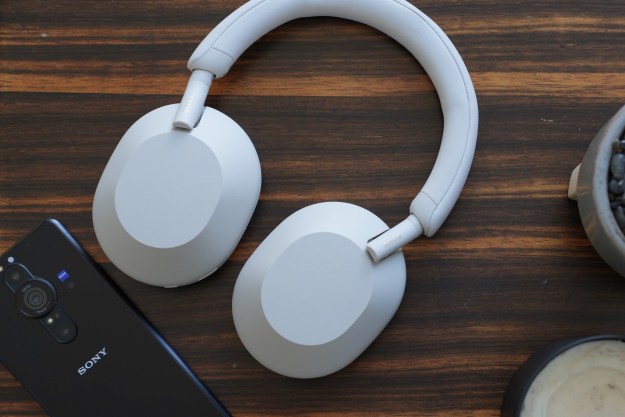Soundbars and surround-sound systems are two of the best ways to experience pulse-pounding sound when watching your favorite movies and TV shows, but sometimes you might want or need to use a pair of headphones with your TV viewing. It's a great way to experience sound-staging on a whole new level, while also keeping the volume down (or off) for your family and neighbors. There's more than one way to connect wirelessly to a pair of cans or buds you're rocking, and we've outlined several of these methods below.
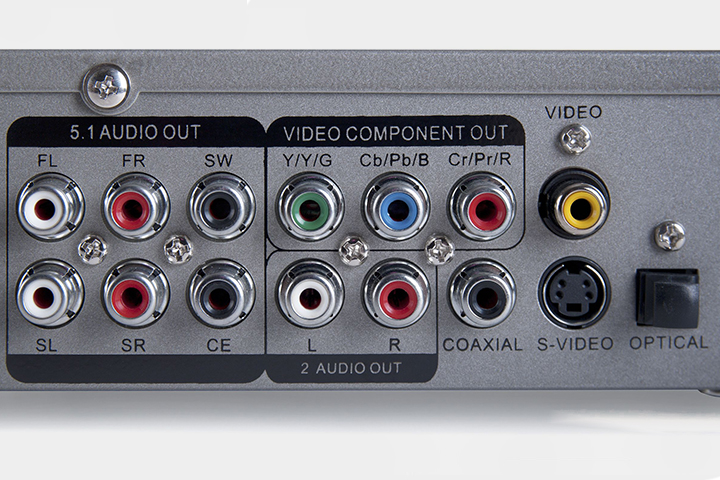
Using a wired adapter
Connecting via an adapter first requires identifying what kind of audio output your TV has. On the back or side of your TV (or wherever your inputs are), there should be some form of audio output connection. In older TVs, there may be a 3.5mm (standard headphone) output, which makes it simple to plug and play.
More commonly, though, older models sport stereo RCA audio jacks, which will require an RCA-to-3.5mm female adapter, like this one from Amazon. This kind of setup is simple and affordable, but not ideal for most scenarios. After all, you probably don't want a long cable snaking through the middle of your living room.
Newer TVs usually drop analog outputs in favor of a digital optical output. The output looks like a tiny, square-shaped door, often outlined in a bright red light (or fitted with a rubber cap). For this configuration, you need a digital-to-analog converter (DAC). This will not only allow you to plug in a 3.5mm headphone jack, but also convert the audio output to the correct format for playback in your headphones. Again, you'll also likely need a headphone extension cable, so you can kick back.

Bluetooth through your streaming device
Streaming video devices like the Apple TV 4K and Amazon's Fire TV Cube also stream audio via Bluetooth. After putting your Bluetooth headphones in pairing mode, just follow the onscreen instructions under the Bluetooth settings for your streaming box and you can begin streaming in no time.
The general rule is that this method will only allow for listening to streaming content from the device you've paired to and won't work as a catch-all solution; that is, unless you've got the 2021 or 2022 version of the Apple TV 4K. That box uses an HDMI eARC connection, letting it act as an audio distribution device for any sound your TV can process.
Roku's many TVs and streaming devices also offer a super-convenient way of sending Roku-based audio to your Bluetooth headphones, and it's all done through the Roku app. In short, there's a feature called "private listening" that automatically mutes your TV sound and sends audio directly to whatever headphones are paired to whatever smartphone or tablet your Roku app lives on.
There are also a number of streaming devices (including many current and older Roku models) that will let you plug a pair of wired headphones directly into the 3.5mm port on the device remote. Hardware like the Roku Ultra, Roku Streaming Stick 4K+, and certain Roku TVs have remote controls with a headphone jack built right in. The optional game pad controller for the Nvidia's Shield TV is another great option.

Connecting through external audio devices
Devices like AV receivers or even external speakers will usually have an accessible connection to plug in a pair of headphones. This is especially handy if you happen to have multiple source devices (e.g., a cable box or antenna, a streaming device, etc.). You'll need to take a look at your hardware to see if there is a headphone output, or you could use one of the output-adapter setups we mentioned above (such as the RCA or digital optical adapters). Most AV receivers will have a quarter-inch headphone input in the front, which requires nothing more than a simple adapter if your
For the vast majority of users,

TV Bluetooth streaming
Today's best TVs are steadily adding Bluetooth streaming as a standard feature. If you have a pair of Bluetooth headphones, you can check to see if your TV supports Bluetooth. This information should be located somewhere in the audio section of the TV's settings. If your TV does support Bluetooth, simply set your
One thing to keep in mind here, however, is latency. Many Bluetooth connections introduce a small amount of lag between the TV and the headphones. While this isn't an issue for music streaming, even nominal lag can create sync issues between the on-screen video and the audio, meaning the actions on the screen will occur a few fractions of a second before you hear the sound.
It can be extremely annoying, especially to audio-minded folks, so you will want to make sure your TV/headphone combination doesn't induce lag before investing in this route. Models with newer versions of the Bluetooth codec (version 5.0 or higher) may be your best bet, though many factors can induce latency. Check to see if your headphones offer a game mode, as this can help reduce lag, albeit at the cost of pristine sound quality.
External Bluetooth adapter
If your TV doesn't have Bluetooth connectivity and you don't own a streaming device with Bluetooth, you can outfit your TV with a Bluetooth transmitter. These devices, which hardwire into your TV and beam out a Bluetooth signal, come in several forms, including USB dongles, 3.5mm dongles, and even breakout boxes. If you can find a Bluetooth adapter that supports the audio output port of your TV, you'll be able to easily pair Bluetooth headphones to it by simply following the pairing instructions that come with each device. Most devices also list latency issues, so check into it before you make a purchase.
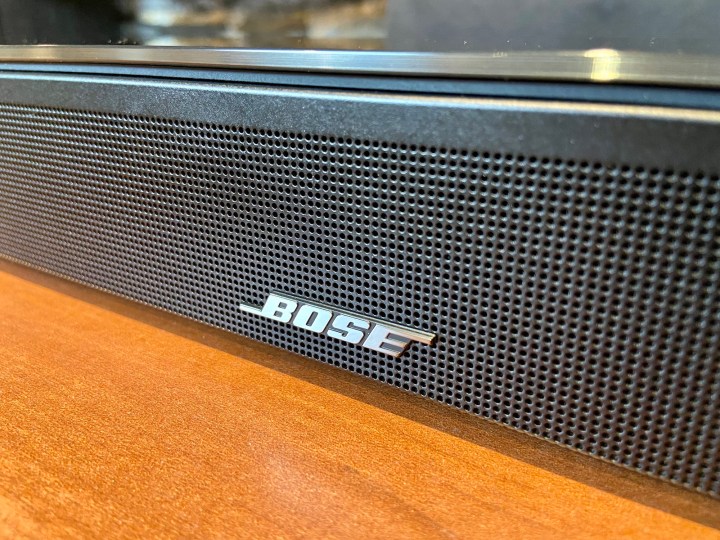
Soundbars
Some soundbars, such as Sony's HT-A5000, not only allow you to stream Bluetooth audio from your phone, but will also allow you to stream sound from them via Bluetooth. This is a great solution for those with Bluetooth headphones, as any audio being sent to the bar can be streamed. Bose also offers this on its family of smart soundbars like the Smart Soundbar 900, 700, and 300, but it's only designed to work with Bose Bluetooth headphones. Again, we caution lag, but more feature-packed soundbars may also adjust for latency, or allow you to do so in the settings. You obviously wouldn't want to buy a soundbar just for this purpose, but if you're looking for better audio in general, this could be well worth considering.
RF headphones
Radio frequency (RF) headphones from companies like Sony and others connect to a base charging station that is directly wired to a TV or other output device, such as a cable box. Whatever your hardware, you need to match the connection types between the base station and your TV or another source device.
Double-check the connection types (optical, RCA, 3.5mm output, etc.), as it's possible you need an adapter to make the link. Despite these potential extra steps, RF headphones are excellent for connecting wirelessly, as they often have better range and far less latency (if any) than Bluetooth
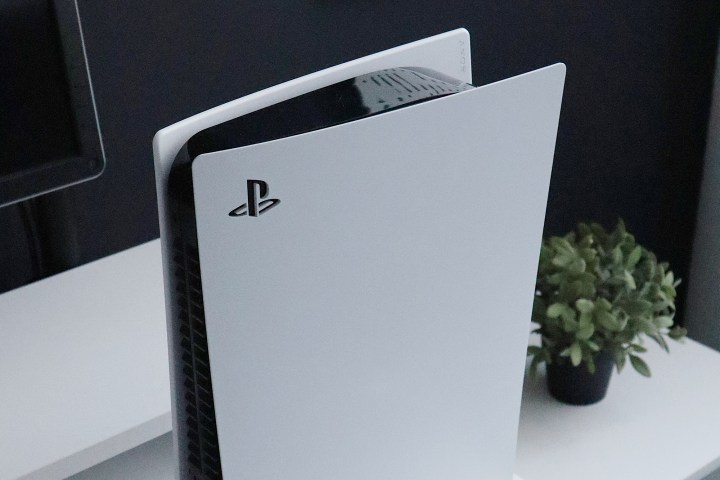
Playstation 5, Playstation 4, and PS4 Pro
The PlayStation 5, PlayStation 4 and PS4 Pro are probably the easiest consoles for connecting headphones or gaming headsets due to their support of several common connection types and simple setup (though it should be noted that many common Bluetooth
If you're going the wired route, the PS5's DualSense and PS4's DualShock 4 controller both have a 3.5mm jack, just under the PlayStation button and between the thumbsticks. Just plug in your wired headset, and you're good to go.
If you're planning to go wireless, the PS5 does not support Bluetooth audio directly at this time, but there's still a way to connect a set of Bluetooth headphones to the PS5. What you'll need is a USB-C or USB-A Bluetooth audio adapter, and getting one up and running is as simple as connecting the adapter to your PS5 and putting it into pairing mode. Then all you have to do is grab your headphones/headset and put them into pairing mode, too. Once a connection is established, you should be able to hear your PS5's audio through your Bluetooth headphones.
If you're using a wired or wireless USB headset and are still rocking a PS4, you can plug the dongle directly into one of the PS4's USB ports.
Your console should quickly identify the headset and begin playback. Note that some USB headsets are designed for PC and require driver downloads or extra software to use features like surround sound or EQ settings. While you will get basic functionality with these headsets on PS4, it's best to look for PS4-specific models to get the best experience.
Finally, select supported Bluetooth headphones are also an option on PS4. To pair the
If this doesn't work, you can also plug the device into the PS4 with a USB cable and allow a few moments for the console to recognize the new headphones.

Xbox Series X, Xbox Series S, and Xbox One
In terms of hardwired headphone connections, both the Xbox Series X and Series S feature 3.5mm headphone connections on the console controllers. Depending on the model year of your Xbox One, the controller may or may not feature this same port.
A wireless connection is a different animal. Xbox consoles do not support Bluetooth, nor do they support the majority of wireless USB headsets. Instead, you will need to seek out Xbox One-specific wireless headsets and then follow the manufacturer's instructions for connecting them.
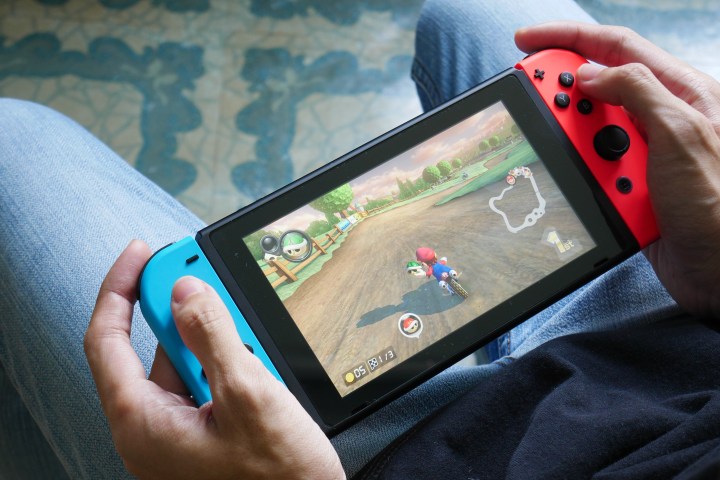
Nintendo Switch
The Nintendo Switch has a few options for connecting 3.5mm and Bluetooth headphones. For wiring directly into the Switch, a headphone jack sits on the upper-left side of the console (Note: This jack only supports audio out, and not mics. To use a mic for voice chat, you need to connect via Nintendo's voice chat app for smartphones.) This can be used whether the console is docked or undocked. Just be mindful of the distance between you and the console when docked so it isn't accidentally pulled out and dropped.
There are two options for connecting Bluetooth headphones: The first is to purchase a Bluetooth receiver dongle that plugs into the 3.5mm jack and pair your Bluetooth
The second option is to plug in the Bluetooth headphones' dongle into one of the USB ports on the Switch Dock. This requires you to have updated to the 4.0 Switch firmware or higher (you can double-check your firmware version under the System menu, as well as check for updates), but once you have the proper version, all you need to do is plug in a USB Bluetooth dongle and wait for the headphones to pair.
While this can only be done while the system is docked, a workaround exists for the handheld mode. You will once again need to be running firmware update 4.0 or higher and will need a USB-to-USB 3.0 adapter to plug into the USB 3.0 port under the system. This setup isn't ideal, but it's an effective workaround nonetheless.
SteelSeries' Arctis line of headphones, such as the excellent Arctis 7 or the Arctis 3 Bluetooth, make for prime choices since they feature both 3.5mm and simple Bluetooth connectivity.

PC
The majority of PCs can support almost any type of headphones or headset, no matter if they are wired or wireless. PCs usually have a 3.5mm jack on the tower's front or back (sometimes they can be on both). Find the small
You can also plug a USB headset into any available port on your PC. Generally, you can start using headsets and headphones immediately after plugging them in; however, there are situations where you'll need to install a driver or a specific type of software to get it officially set up. If you're not sure exactly what you need to get them working, we recommend checking your manufacturer's informational guides.
The good news is most PCs are Bluetooth-compatible. You can easily pair your headphones to your computer by switching your Bluetooth device into discovery mode and then turning Bluetooth on via your PC's audio settings. Your computer should immediately recognize the Bluetooth device, and once you're all connected, you're ready to listen to whatever you want.
Editors' Recommendations
- Best Vizio TV deals: Cheap smart TVs starting at $90
- Best headphone deals: AirPods, Sony, Sennheiser and more
- Best soundbars of 2024: a sound upgrade for your TV
- Best Sony TV deals: Save on best-in-class 4K TVs and 8K TVs
- Best projector deals: Replace your TV with a big screen from $80



